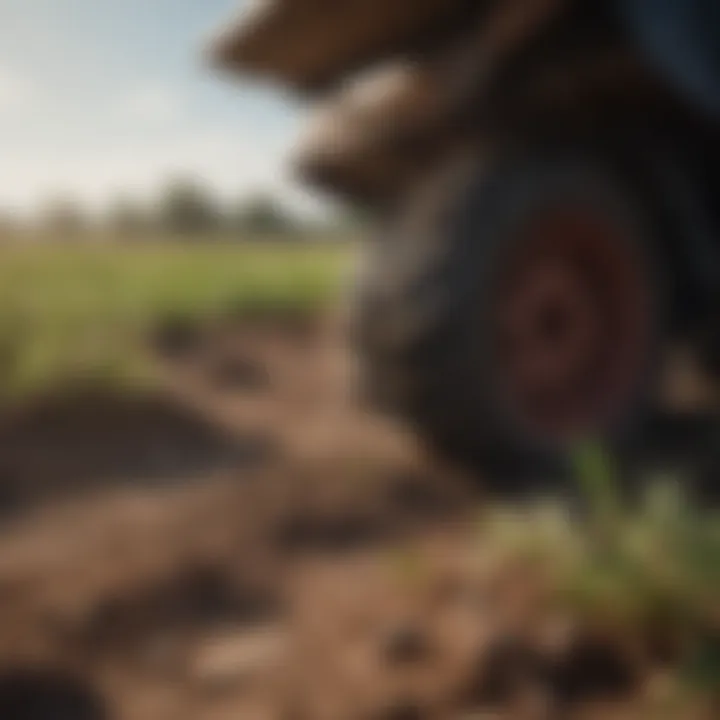Comprehensive Insights into Soybean Farming Practices


Overview of the Topic
Definition and Importance
Soybean farming has become a fundamental part of modern agriculture. Soybeans are not just a crop; they represent a critical source of protein and oil across the globe. These legumes are often used in animal feed, cooking oils, and various food products. The significance of soybean farming lies not only in its economic contributions but also in its role in sustainable agriculture.
Growing soybeans can improve soil health through nitrogen fixation. This means the plants enrich the soil with nitrogen, which is essential for other crops. It also contributes to crop rotation systems, enhancing biodiversity and resilience in farming practices. Understanding the nuances of soybean farming leads to better yield and sustainability.
Current Trends
The current trends in soybean farming demonstrate a shift towards sustainability and precision agriculture. Farmers are increasingly adopting technologies like precision planting and soil health monitoring. This helps to optimize input use and enhance productivity.
There is a growing interest in organic soybean farming as consumers demand more sustainable food sources. Moreover, research into genetically modified organisms (GMOs) continues to influence the market. Farmers are now exploring non-GMO varieties, meeting a niche demand.
Key Techniques and Practices
Step-by-Step Guide
- Site Selection: Choose a site with good drainage and fertility. Soybeans need well-drained soils with pH levels between 6.0 and 7.0.
- Variety Selection: Identify suitable soybean varieties based on climate and market demand. Consider disease resistance and yield potential.
- Soil Preparation: Conduct soil tests and prepare the land accordingly. Tilling might be necessary for proper seedbed preparation.
- Sowing: Plant soybeans at the right time, often in late spring or early summer, when soil temperatures are ideal.
- Irrigation and Fertilization: Use irrigation wisely, and apply fertilizers based on soil test recommendations.
- Pest Management: Monitor for pests and diseases throughout the growth cycle. Utilize integrated pest management techniques to control threats.
- Harvesting: Harvest soybeans when moisture content is at an optimal level for storage and processing.
Tools and Equipment Needed
- Tractors: Essential for soil preparation and planting.
- Seeders: Precision seeders help improve planting accuracy.
- Sprayers: For pest management and fertilization.
- Harvesters: Combine harvesters are commonly used for efficient harvesting.
Challenges and Solutions
Common Obstacles
Soybean farmers face several challenges:
- Pest Infestation: Insects like aphids can damage crops.
- Weed Management: Weeds compete for nutrients and light, reducing yield.
- Market Fluctuations: Prices can be unstable, affecting profitability.
Innovative Solutions
- Integrated Pest Management: Incorporating biological controls and resistant varieties can help combat pests.
- Cover Cropping: This can manage weeds and improve soil quality.
- Agri-Tech Solutions: Utilize apps and software for tracking growth stages and market conditions.
"A key to successful soybean farming is a combination of traditional knowledge and modern technology."
Focusing on these insights can elevate both productivity and sustainability in soybean farming. Understanding the full scope of growing, managing, and marketing this crop will ensure success in this vital sector of agriculture.
Preface to Soybean Farming
Soybean farming plays a vital role in contemporary agriculture. It is not just about production; it encompasses a broader spectrum of benefits that impact various economic and ecological facets. Understanding the nuances of soybean farming is essential for agricultural professionals and enthusiasts alike. This section aims to elaborate on its significance.
Soybeans are among the most versatile crops grown worldwide. Not only do they serve as a primary source of protein and oil, but they also contribute to soil health through nitrogen fixation. This dual benefit makes them an ideal choice for sustainable farming practices. Additionally, soybeans provide essential nutrients for animal feed, thus supporting the livestock industry.
In recent years, the demand for soy-based products has surged. This is due to rising global population and shifting dietary preferences. As a result, effective soybean farming is not just beneficial but crucial for meeting food security needs.
Historical Context
The cultivation of soybeans originated in East Asia. Historical records suggest that soybeans were grown in China as early as 1100 B.C. Initially valued for their nitrogen-fixing abilities, it was not until the 18th century that soybeans made their way to the United States. The crop gained traction in the U.S. during World War II when it became important for its oil and protein. The latter part of the 20th century saw a significant increase in soybean production, largely driven by advancements in agricultural technology and breeding.
Understanding the historical context sheds light on the exponential growth and adaptation of soybean farming. It allows farmers to learn from the past, applying traditional methods alongside modern innovations for improved yield and sustainability.
Current Global Trends
As the agricultural landscape evolves, several trends are emerging in soybean farming. Some of the most notable include:
- Sustainability Focus: There is an increasing emphasis on sustainable farming practices, including cover cropping and reduced chemical use.
- Technological Integration: Precision agriculture technologies are becoming widely adopted. GPS-guided equipment helps optimize planting and harvesting.
- Global Market Dynamics: Countries like Brazil and Argentina have become key players in the global soybean market, leading to shifts in trade policies and regulations.
- Consumer Preferences: The rise in vegetarian and vegan diets has heightened demand for soy products as protein substitutes.
These trends illustrate that soybean farming is not static but rather dynamic and responsive to changing societal needs. Farmers who stay informed and adaptable will likely excel in this competitive environment.
"The future of soybean farming relies on innovation and adaptation to changing market needs and ecological challenges."
In summary, understanding the historical context and current global trends in soybean farming provides a comprehensive overview of the importance of this crop in today’s agricultural landscape. As we move forward, it is crucial to remain informed and engaged with ongoing changes and advancements in the field.
Importance of Soybeans in Agriculture
Soybeans play a critical role in modern agriculture, influencing both dietary health and economic stability around the world. This section will explore the various facets of soybeans that establish their importance in agricultural practices and beyond.
Nutritional Value
Soybeans are known for their high nutritional profile. They are rich in protein, making them a vital component for many diets. A single cup of cooked soybeans contains about 29 grams of protein, providing essential amino acids that are crucial for human health.
In addition to protein, soybeans are a source of healthy fats, fiber, vitamins, and minerals. They contain various micronutrients, such as iron, calcium, and potassium, which contribute to overall well-being.
Furthermore, soy products, such as tofu and soy milk, are often utilized as meat substitutes in vegetarian and vegan diets. This positions soybeans as a sustainable solution to meet global protein demands.
Economic Contributions
The economic significance of soybeans cannot be understated. In many countries, soybeans are among the top cash crops. Their cultivation supports numerous livelihoods across the agricultural sector. For example, in the United States, soybeans are one of the leading crops, generating billions of dollars annually.
The soybean market extends beyond mere cultivation. It influences various industries, including animal feed production, oil extraction for cooking and industrial use, and biofuels.
Moreover, soybeans are exported worldwide, impacting trade balances for producing countries. The demand for soy has been steadily increasing, particularly in emerging markets, contributing to the growth and resilience of agricultural economies.
"Soybeans have become a staple of the global agricultural economy, driving both domestic and international trade."
In summary, soybeans have profound implications for nutritional health and economic viability in agriculture. Their unique properties and global demand underline their vital role as a fundamental crop, contributing to food security and agricultural sustainability.
Soil Preparation Techniques
Soil preparation is a critical step in soybean farming that establishes the foundation for a productive crop. It is about optimizing soil conditions to enhance plant growth, supporting not just healthy roots but overall yield. Proper techniques can boost soil fertility, structure, and moisture retention, ultimately leading to healthier soybeans and higher profits. Farmers must carefully consider these techniques to address the unique challenges posed by their soil type and regional climate.
Soil Testing and Amendments
Conducting soil tests is essential for understanding the nutrient composition and pH levels of the soil. These tests provide invaluable data, allowing farmers to make informed decisions regarding amendments. The primary goal is to adjust nutrient levels to meet the specific needs of soybean plants.
The testing process typically involves:
- Sample Collection: Taking samples from various locations within the field to ensure a representative analysis.
- Laboratory Analysis: Sending samples to a lab to evaluate nutrient levels, pH, and organic matter content.
- Interpretation: Understanding the results to make decisions about necessary amendments.
Common amendments based on soil test results may include:


- Lime to raise pH
- Sulfur to lower pH
- Nitrogen, phosphorus, and potassium fertilizers to enhance nutrient levels.
Proper soil testing establishes a baseline, which is crucial for successful soybean farming.
Tillage Practices
Tillage is the practice of turning over and preparing the soil for planting. It influences soil structure, moisture retention, and weed control. Farmers choose tillage methods that align with their sustainability goals and soil conditions.
Different tillage systems include:
- Conventional Tillage: Involves complete soil inversion, which can enhance decomposition of crop residues. However, it may lead to increased erosion and moisture loss.
- Conservation Tillage: Minimizes soil disturbance by leaving some plant residues on the surface. This technique can improve soil health, reduce erosion, and enhance moisture retention.
- No-Till: This method avoids tilling altogether, planting directly into the residue of the previous crop. No-till systems often increase organic matter in the soil and improve biodiversity, but they require precise management to prevent weed issues.
In summary, effective soil preparation techniques, including thorough soil testing and appropriate tillage practices, play a significant role in ensuring successful soybean farming. They help in developing a robust growing environment that can lead to increased yields and better economic outcomes.
Selecting Soybean Varieties
Selecting the right soybean variety is critical for the success of farming operations. The choice of variety affects yield, disease resistance, and adaptability to different environmental conditions. An informed decision can lead to higher productivity and better marketability of the crop. It is not just a matter of picking a popular choice, but understanding the specific needs and conditions of your farming environment.
Key Characteristics to Consider
When selecting soybean varieties, certain characteristics must be evaluated. These include:
- Yield Potential: Assessing the yield potential of a variety is crucial. High-yielding varieties can maximize output, which is vital for profitability.
- Disease Resistance: Opt for varieties with resistance to common diseases like soybean rust or soybean cyst nematode. This can reduce the need for chemical treatments and improve crop health.
- Maturity Group: Different maturity groups are suited for various climates. Selecting a variety with a maturity group that aligns with local conditions ensures optimal growth and harvesting times.
- Seed Quality: High-quality seeds are essential for successful planting. Look for seeds with high germination rates and vigor.
- Market Demand: Consider the market preferences for soybean varieties. Some markets may favor specific traits like oil content or color.
Choosing a soybean variety involves weighing these factors carefully. A well-selected variety can withstand environmental stresses and provide a lucrative return.
Regional Variety Adaptation
Regional adaptation is another significant aspect of selecting soybean varieties. Certain varieties excel in specific climates and soil conditions. Here are a few points to consider:
- Climate Suitability: Varieties need to be chosen based on regional climatic conditions. For instance, some varieties may thrive in humid regions while others are better suited for drier environments.
- Soil Type: Different soybean varieties may require specific soil conditions to flourish. For example, loamy soils may support different varieties compared to clay or sandy soils.
- Local Expertise: Reach out to local agricultural extension services or farmers to learn about what varieties have historically performed well in your area.
"Selecting a soybean variety that is well-adapted to the local environment is often the first step to achieving a successful harvest."
Ultimately, understanding and implementing these considerations can lead to optimal soybean farming outcomes. The right selection process not only ensures a good yield but also fosters sustainability and resilience in soybean farming.
Planting Methods
Planting methods in soybean farming are crucial for achieving optimal yields and ensuring the health of the crop throughout its growth cycle. Effectively managing how and when soybeans are planted can lead to improved crop performance. This section explores key elements such as timing, spacing, and the equipment used, which all contribute significantly to the success of soybean farming.
Timing and Spacing
Timing and spacing are critical components that impact soybean growth. It is essential to plant soybeans at the right time, as this aligns with environmental conditions. Planting too early can expose seeds to cold soil temperatures, potentially causing poor germination. Conversely, planting too late may miss the ideal growing season, affecting final yield.
Spacing between plants also affects growth and overall health. Optimal spacing allows for adequate light exposure, air circulation, and nutrient availability. Farmers should aim for a spacing of approximately 15 to 30 inches between rows, depending on the specific variety and local practices. These parameters can vary based on agricultural zones and soil types. To help ensure uniform plant development, farmers often utilize precision planting techniques.
Seeding Equipment
The choice of seeding equipment is vital in the soybean planting process. There are various types of planters available, each designed for specific needs. For instance, vacuum planters offer accuracy in seed placement, reducing seed waste and improving germination rates. Other options include row crop planters and drill seeders, which also provide flexibility in terms of planting depth and spacing.
When selecting seeding equipment, farmers should consider the following:
- Field Conditions: Equipment must be suited for the type of terrain and soil conditions.
- Seed Variety: Different soybean varieties may require distinct planting techniques.
- Technology Integration: Some modern planters come equipped with digital technology, allowing for better management of planting parameters.
Utilizing appropriate seeding equipment can enhance efficiency and promote healthy crop establishment, key factors for maximizing yield potential.
"Choosing the right planting method can set the foundation for a successful soybean crop that thrives under the chosen environmental conditions."
By giving careful thought to planting methods, farmers can improve their chances for successful soybean production. This not only supports their livelihood but also contributes to the sustainability of agricultural practices.
Crop Management Practices
Crop management practices are essential in ensuring the optimal growth and yield of soybean crops. These practices encompass a broad range of activities, techniques, and strategies. By focusing on effective crop management, farmers can improve productivity, enhance sustainability, and respond to challenges in agriculture. Proper management acts not just as a framework for farming but also influences economic outcomes.
One significant aspect of crop management is its ability to increase resilience against various stresses, which may be environmental or biological. Implementing appropriate practices helps mitigate risks associated with pests, diseases, and changing climate patterns.
Irrigation Strategies
Irrigation is a crucial practice in soybean farming, particularly in areas where rainfall is inconsistent. Adequate hydration is vital for soybean growth, as water stress can lead to reduced yields and lower quality produce. Farmers must develop strategies that ensure their crops receive the right amount of water throughout their growth cycle.
Several irrigation methods can be utilized, including:
- Drip Irrigation: This method delivers water directly to the root zone of plants, minimizing waste. It efficiently conserves water and can improve overall crop health.
- Sprinkler Systems: Sprinklers simulate rainfall, allowing for broader coverage. An advantage is that they can be used to cool crops during high-temperature days.
- Surface Irrigation: This traditional method involves flowing water over the soil surface. It is less efficient and often criticized for potential waterlogging issues.
Monitoring soil moisture levels through technology such as moisture sensors can enhance irrigation practices. Accurate readings of soil moisture will guide farmers when to irrigate, preventing both under-watering and over-watering of crops.
Fertilization Techniques
Fertilization plays a critical role in the productivity of soybean crops. Nutrient management influences not only the growth of the plants but also the quality of the beans produced. A successful fertilization strategy involves understanding the specific nutrient needs of soybeans at different growth stages.
Key considerations for fertilization include:
- Soil Testing: Regularly testing soybeans’ growing soil helps identify nutrient deficiencies or excesses. This informs a targeted fertilization plan.
- Balanced Nutrient Application: Soybeans primarily require nitrogen, phosphorus, and potassium. Utilizing a balanced approach helps maintain soil health and promotes plant vigor.
- Timing: Application timing can significantly impact nutrient absorption. Fertilizers may be applied before planting, at planting, or during the growing season, depending on the nutrient needs.
Implementation of slow-release fertilizers can improve nutrient uptake efficiency. This approach ensures that nutrients are available for extended periods, aligning with the plant's needs.
"Effective crop management practices enhance both yields and sustainability, ultimately shaping the future of soybean farming."
Pest and Disease Management
Effective pest and disease management is crucial in soybean farming. Pests and diseases can drastically reduce crop yields and affect the overall health of the plants. Proper management strategies lead to healthier crops and sustainable farming practices. By understanding pests and diseases, farmers can take proactive measures to protect their harvest. These measures also enhance long-term productivity and economic stability in soybean farming.
Common Pests and Their Control
Common pests in soybean fields include the soybean aphid, spider mites, and the corn rootworm. Each of these pests has unique behaviors and damage patterns which requires targeted control measures.
- Soybean Aphid: This tiny green insect can quickly infest fields, sucking sap from the plants and stunting their growth. Controlling soybean aphids often involves monitoring their population levels, using resistant soybean varieties, and applying insecticidal sprays if necessary.
- Spider Mites: These pests thrive in hot, dry conditions and can cause significant damage by feeding on plant cells. Regular irrigation and maintaining plant health through proper practices can help reduce their impact. In severe cases, miticides may be employed for control.
- Corn Rootworm: Both the larvae and adult beetles can damage roots and weaken plants. Crop rotation is an effective prevention strategy, as it disrupts their life cycle. Additionally, targeted insecticides may be used to manage adult populations.
Key Control Strategies:
- Monitor fields regularly for signs of pests.
- Use beneficial insects, like ladybugs, that prey on harmful pests.
- Rotate crops and practice integrated pest management to reduce pest populations.
"Regular monitoring, proper timing, and strategic use of control methods are key in managing pests effectively."


Disease Identification and Management
Diseases are another major threat to soybean crops, hindering growth and yield. Recognizing and managing diseases timely is essential. The most common diseases impacting soybeans include soybean rust, downy mildew, and root rot.
- Soybean Rust: This fungal disease can be particularly devastating, leading to significant yield losses. Monitoring weather conditions and scouting for early signs of infection can help in early identification. Resistant soybean varieties and timely application of fungicides are effective management strategies.
- Downy Mildew: This disease thrives in humid conditions and can affect young plants. Cultural practices such as proper spacing and crop rotation can help minimize its spread. Fungicide treatments may also be utilized based on disease severity.
- Root Rot: Caused by various fungi, root rot can lead to plant wilting and death. Maintaining healthy soil and adhering to good drainage practices can mitigate the risk. Resistant cultivars are available to help farmers protect their crops.
Important Management Considerations:
- Conduct regular health inspections to identify diseases early.
- Implement crop rotation to disrupt disease cycles.
- Use disease-resistant varieties wherever possible.
Through rigorous pest and disease management strategies, soybean farmers can minimize risks and enhance their overall crop yield. Understanding these threats is vital for sustainable and profitable farming.
Weed Control Strategies
Weed control is a critical component of soybean farming. The presence of weeds can significantly impact soybean yields by competing for nutrients, water, and light. Effective weed management improves the overall health of crops and enhances productivity. Farmers must understand various strategies for managing weeds to ensure a successful harvest.
Cultural and Mechanical Practices
Cultural practices involve modifying farming techniques to reduce weed growth. Crop rotation is one significant method; it disrupts the life cycles of weeds by alternating crops that have differing growth characteristics. For instance, switching between soybeans and a cereal crop can confuse and hinder weed establishment.
Mechanical practices are also effective. Tillage before planting can help control weed seeds present in the soil. However, excessive tillage can lead to soil erosion and degradation, so farmers should balance these practices carefully. Using implements like hoes or cultivators during the growing season can help manage weeds while minimizing disruption to the soybean plants.
Some essential steps in cultural and mechanical weed management include:
- Monitoring fields frequently: It helps to identify and manage weed populations early.
- Maintaining crop competitiveness: This can involve adjusting seeding rates to promote healthier soybean plants that can better compete with weeds.
- Timing of mechanical interventions: Performing tillage or cultivation when soils are moist can improve effectiveness while reducing stress on soil structure.
Herbicide Use and Resistance Management
Herbicide application is a common practice in soybean farming, providing targeted control of weed species. However, reliance on herbicides can lead to the emergence of resistant weed populations, which complicates management efforts. Thus, developing a balanced approach is crucial.
Farmers should consider the following strategies for effective herbicide use:
- Rotation of herbicides: Using products with different active ingredients can help prevent resistance. This may involve rotating herbicides with various modes of action, which disrupts weed survival.
- Integrated Weed Management (IWM): This approach combines cultural, mechanical, and chemical methods for a holistic strategy against weeds. Incorporating various methods reduces dependence on any single control measure.
- Timing and application rates: Proper timing can maximize herbicide effectiveness while minimizing negative impacts on soybean plants. Adhering to recommended application rates is also essential to prevent resistance.
"Integrated Weed Management requires a comprehensive strategy that fuses multiple techniques for optimal effectiveness."
In summary, effective weed control strategies encompass a mix of cultural, mechanical, and herbicide management practices. Farmers in soybean production must carefully evaluate which methods align best with their specific conditions. This balanced approach leads to healthier crops, enhanced yields, and ultimately, a more sustainable farming system.
Harvesting Techniques
Harvesting techniques are crucial in the soybean farming process. This phase determines the quality and quantity of the yield. Proper harvesting not only affects the profitability of the crop but also influences future crop rotations. Organizing the harvest efficiently ensures that farmers maximize their resources and reduce losses.
Optimal Timing for Harvest
Timing is a key factor in successful soybean harvesting. Each year, factors like weather and soil conditions change, affecting when it is best to harvest. Generally, soybeans should be harvested when the moisture content of the seeds is around 13 to 15 percent. Harvesting too early can result in lower yield. Conversely, waiting too long increases the risks of shattering and decay.
Farmers can use several indicators to determine the optimal time:
- Pod Color: Pods should turn brown and dry.
- Leaf Drop: Leaves will start yellowing and falling off.
- Seed Appearance: Seeds should be firm and well-formed.
Utilizing tools such as moisture meters can help achieve accurate assessments and prevent unnecessary loss.
Harvesting Equipment and Methods
The choice of harvesting equipment significantly impacts the efficiency of soybean harvesting. Commonly, farmers use combines equipped with soybean headers for the task. These machines are designed specifically to handle the delicate nature of soybeans and to minimize damage during the process.
Different methods of harvesting can be considered, including:
- Conventional Harvesting: Using combines that can collect, thresh, and clean soybeans in one pass.
- Manual Harvesting: In areas where technology is limited, farmers might resort to hand tools, although this is increasingly rare.
The effectiveness of these methods can depend on the size of the farm, budget, and the available workforce. Choosing the right equipment can make a substantial difference in harvest efficiency, helping to achieve a higher yield.
"Harvesting at the right time with the right equipment is essential to maintaining crop quality and ensuring successful soybean farming."
In summary, understanding both the optimal timing for harvest and the necessary equipment is essential for successful soybean production. These aspects, when carefully managed, lead to enhanced productivity and long-term sustainability in farming.
Post-Harvest Management
Post-harvest management is a crucial phase in soybean farming that can significantly affect the overall productivity and economic viability of the farming operation. After the harvest, handling soybeans properly ensures quality preservation and market readiness. This stage encompasses various processes, including storage, grading, and marketing. Proper management is essential to prevent losses and maximize profitability.
Storage Techniques
Effectively storing harvested soybeans requires an understanding of optimal conditions. Key factors include temperature, humidity, and airflow. Maintaining a low moisture level is critical to prevent mold and spoilage. Ideally, the moisture content should be below 13%.
Storage facilities often use ventilation systems to reduce moisture and preserve seed quality. Grain bins are a common solution, as they facilitate aeration. Regular monitoring of temperature and moisture levels is critical. Fumigation can also be necessary to protect soybeans from insects and rodents.
Factors to consider in storage techniques:
- Temperature Control: Keep stored soybeans cool. Ideal temperatures are between 20°C and 25°C.
- Moisture Management: Aim for a moisture content of less than 13%. Check regularly.
- Pest Protection: Use fumigation as needed, and monitor for infestations.
"The right storage can prevent losses and maintain market quality for soybeans."
Market Considerations
When it comes to selling harvested soybeans, understanding market dynamics is vital. This includes knowing current prices, demand trends, and potential buyers. Soybean prices can fluctuate based on factors such as global supply and demand, weather conditions, and trade policies. Therefore, keeping up with market trends is essential for making informed selling decisions.
It may be prudent for farmers to establish relationships with several buyers to enhance market access. Contracts or agreements with buyers can secure a reasonable price ahead of the harvest season.
Several factors influence market considerations:
- Market Research: Stay up-to-date on current pricing and trends worldwide.
- Buyer Relationships: Develop connections to ensure diverse selling options.
- Trade Policies: Understand how international agreements might impact soybean prices.
In summary, post-harvest management, particularly in storage techniques and market considerations, plays an integral role in the success of soybean farming. Implementing effective strategies can enhance profit margins and ensure the sustainability of farming practices.
Sustainable Practices in Soybean Farming
Sustainable practices in soybean farming are essential for ensuring long-term productivity and environmental health. As soybean demand grows, it becomes vital to implement strategies that minimize negative impacts on ecosystems while maintaining economic viability. This section will explore the importance of two key sustainable practices: cover cropping and soil conservation techniques. These methods not only enhance soil health but also support biodiversity and improve yields over time.
Cover Cropping
Cover cropping is a farming practice that involves planting specific crops during the off-season or between primary crops. This is done to achieve several objectives:
- Soil Quality Improvement: Cover crops help in adding organic matter to the soil. Crops like clover or rye can fix nitrogen, enhancing soil fertility.
- Erosion Control: The roots of cover crops stabilize the soil, reducing erosion caused by wind or water. This is crucial in keeping nutrients in place.
- Weed Suppression: By shading the soil, cover crops limit weed growth, which reduces the need for herbicides.


These benefits make cover cropping a valuable strategy for soybean farmers looking to optimize their resources sustainably. Implementing a cover crop rotation can lead to healthier soils and, ultimately, better soybean harvests.
Soil Conservation Techniques
Soil conservation is a cornerstone of sustainable agriculture, particularly in soybean farming. Effective techniques include:
- No-till Farming: This method minimizes soil disturbance and helps maintain soil structure. It prevents erosion and retains moisture, which is beneficial during dry periods.
- Contour Farming: By planting along the contours of the land, farmers can reduce runoff and soil loss on slopes. This preserves both soil and water.
- Crop Rotation: Rotating soybeans with other crops can break pest and disease cycles, leading to healthier plants and better soil nutrient balance.
Utilizing these soil conservation techniques can lead to significant improvements in long-term farm productivity.
"Sustainable farming practices are not just beneficial; they are necessary for the future of agriculture."
Emerging Technologies in Soybean Farming
Emerging technologies within soybean farming are reshaping the landscape of agricultural practices. These advancements play a critical role in improving yields, optimizing resource use, and ensuring sustainable farming methods. In an era where food security is paramount, understanding these technologies is vital for soybean farmers and agricultural enthusiasts alike.
Precision Agriculture
Precision agriculture is at the forefront of modern farming techniques. This approach utilizes data-driven solutions to enhance productivity. Farmers use precision tools, such as GPS and remote sensing technologies, to gather data about their fields. This information helps in making informed decisions.
Benefits of precision agriculture include:
- Enhanced Yield: By analyzing soil health and moisture levels, farmers can apply resources only where needed, leading to substantial yield increases.
- Resource Efficiency: This method reduces waste of water, fertilizers, and pesticides. Consequently, it can lower costs while minimizing environmental impacts.
- Data Management: Accurate data collection allows for long-term planning and tracking of field performance.
However, implementing precision agriculture requires investments in technology and training. Farmers must adapt to new systems and ensure they have access to reliable data.
Biotechnology Innovations
Biotechnology is another significant component of advancing soybean farming. Genetic engineering and molecular biology techniques are being used to develop soybean varieties that are more resilient to pests and environmental stresses. Innovations in biotechnology can lead to:
- Genetically Modified Organisms (GMOs): These crops can withstand herbicides, pest attacks, and changing climate conditions. Farmers benefit from higher yields and lower production costs.
- Nutritional Enhancements: Certain biotech varieties of soybeans are engineered for improved nutritional content, providing more health benefits.
- Disease Resistance: Enhanced varieties can help manage diseases more effectively. This leads to reduced reliance on chemical treatments and improves environmental sustainability.
Despite the advantages, the adoption of biotechnology is often met with skepticism among consumers. Clear communication about the benefits and safety of these innovations is essential for fostering public acceptance.
"Innovations in biotechnology will play a crucial role in securing the future of soybean farming, addressing food security challenges while promoting sustainability."
Policy Implications for Soybean Farmers
Understanding policy implications is crucial for soybean farmers as it can greatly affect their operations and profitability. Policies related to trade, environmental regulations, and support programs are particularly important. Farmers must navigate these policies not only to comply but also to optimize their production capabilities and market reach.
Key factors that influence soybean farming policy include national and international trade agreements, subsidy programs, and environmental expectations. Soybean farmers need to engage with these factors proactively to secure their livelihoods and ensure the sustainability of their practices.
Trade Policies and Market Access
Trade policies directly impact the market access for soybean farmers. These policies can define tariffs and quotas on soybean exports and imports. For example, when large countries like the United States, Brazil, or Argentina engage in trade negotiations, the outcomes can influence prices and availability for farmers.
Benefits of favorable trade policies include:
- Increased market opportunities: Access to a broader market can enhance sales.
- Price stability: Favorable agreements can prevent dramatic price fluctuations, aiding in financial planning.
- Export incentives: Governments might provide support for farmers exporting their products, adding an extra layer of profit.
However, trade disputes can arise, making it essential for farmers to stay informed about negotiations and policy shifts. Farmers should be advocates for their interests by participating in policy discussions through agricultural associations and local governments.
Environmental Regulations
As environmental concerns continue to grow, so do regulatory frameworks concerning sustainable farming practices. Soybean farmers must comply with regulations that aim to protect soil health, water quality, and biodiversity. These regulations can include limits on pesticide use, water conservation measures, and mandates for preserving natural habitats.
Compliance with environmental regulations may seem burdensome, but it often brings long-term benefits, such as:
- Better soil health: Sustainable farming can enhance soil quality, leading to improved yields over time.
- Enhanced marketability: Products grown in compliance with environmental standards can access premium markets.
- Government assistance: Farmers may qualify for grants or subsidies for implementing sustainable practices.
Financial Considerations in Soybean Production
Understanding financial considerations is essential for soybean farmers aiming to optimize their production systems. Financial planning in agriculture is not only about tracking expenses and revenues but also about strategically managing risks associated with farming. This section will shed light on two critical components: cost analysis and budgeting, and profitability and risk management. Each of these aspects can significantly affect the financial health and long-term sustainability of soybean farming operations.
Cost Analysis and Budgeting
Cost analysis in soybean farming involves examining all expenses incurred throughout production. This includes costs associated with seed purchases, fertilizer, pesticides, labor, machinery, and general operating expenses. By understanding these costs, farmers can develop precise budgets that reflect their operational goals and resources.
Creating a budget helps in identifying areas where efficiencies can be realized. Farmers can use various methods, including:
- Historical Data: Reviewing past expenses allows farmers to foresee future costs and identify trends.
- Market Research: Exploring current prices for inputs and anticipated market conditions aids in setting a realistic budget.
- Variable vs. Fixed Costs: Distinguishing between these types of costs can help in planning for unexpected changes in the market or environmental conditions.
Thorough** cost analysis** and effective budgeting empower farmers to make informed decisions that enhance their profit margins.
Profitability and Risk Management
In the landscape of agriculture, particularly soybean production, profitability is influenced by numerous factors including market demand, crop yield, and input costs. To ensure financial sustainability, farmers must continuously monitor these elements.
Profitability can be enhanced through:
- Yield Optimization: Adopting advanced agricultural practices to increase crop yields can lead to greater profits.
- Diversification: Growing multiple crops or introducing complementary farming activities can reduce financial risks.
- Strategic Selling: Timing the market can be critical. Selling at peak prices rather than during harvest can result in higher profits.
Understanding risk is equally important. Factors such as weather conditions, market volatility, and governmental policies can substantially affect farm revenues. To mitigate these risks, farmers can implement several strategies:
- Insurance: Crop insurance can protect against losses from natural disasters.
- Contracts: Forward contracts can stabilize prices and provide predictability in revenue.
- Financial Reserves: Setting aside funds for unexpected expenses ensures some flexibility in times of distress.
Effective financial management not only safeguards profits but also lays the groundwork for long-term sustainability in soybean farming.
Future Prospects of Soybean Farming
The future of soybean farming represents a vital component of agricultural strategy on a global scale. As consumer preferences shift and environmental challenges escalate, understanding the future prospects of this crop becomes essential for agricultural stakeholders. Soybeans are not just a staple food; they are also integral to animal feed, oil production, and emerging biofuels. Therefore, evaluating the market dynamics and anticipating future trends is crucial for informed decision-making and sustainable practices in production.
Global Demand Trends
Global demand for soybeans is anticipated to increase continuously. Factors contributing to this trend include growing populations, rising protein consumption in developing nations, and heightened interest in plant-based diets. As more individuals seek alternatives to animal protein, soy products like tofu, tempeh, and soy milk become increasingly popular. The Food and Agriculture Organization predicts that global soybean production could rise significantly to meet this demand.
Growing economies in countries like India and China contribute to the surge in demand. Additionally, the expansion of livestock farming in these regions increases the need for soybean meal as a crucial animal feed component. These factors underscore a growing market, which any farmer should consider in their production strategies.
Farmers must also be ready to adapt to these shifts by selecting suitable cultivars that align with market preferences. Innovations in sustainable farming practices can further enhance yield and respond effectively to this rising demand.
Adaptation to Climate Change
Climate change poses challenges that directly impact soybean farming. Farmers must be aware of changing weather patterns that can affect planting schedules, growth cycles, and overall yields. The adaptation strategies must focus on finding resilient crop varieties, implementing water management systems, and maximizing the efficiency of inputs. Moreover, understanding crop rotation and soil health is essential to maintaining productivity under unpredictable conditions.
Some farmers are turning to breeding programs that focus on developing drought-resistant or heat-tolerant soybean varieties. This research can ensure that crops withstand adverse environmental conditions, ultimately preserving yields despite climate fluctuations.
Sustainable practices such as cover cropping and reduced tillage can also provide benefits. These methods enhance soil health and help mitigate some impacts of climate change. Farmers who proactively address these challenges will be better positioned to capitalize on future market opportunities.
"Both of these dimensions—global demand trends and climate adaption—serve as critical catalysts for innovation in soybean farming. The future is not only about responding to demands but also about thriving in an ever-changing environment."



